#covid 19 projects
Text
ProjectN95 is shutting down
Tumblr Friends!
ProjectN95 is unfortunately closing its doors on December 15th. They've done SO much to provide masks, respirators, PPE to healthcare workers and the public since 2020, and this is honestly such a loss of a non-profit organization. They've helped a lot of people over these years.
If you need quality masks/respirators, they're having a sale right now on ProjectN95.org. I definitely recommend checking them out sooner than later.
7K notes
·
View notes
Text


#universal basic income#UBI#social welfare#unconditional transfer payment#means test#guaranteed minimum income#poverty line#full basic income#partial basic income#pilot projects#Mongolia#Iran#child benefit#pension#Bolsa Familia#Thamarat Program#economic crisis#COVID-19 pandemic#direct payments#Alaska Permanent Fund#negative income tax#NIT
174 notes
·
View notes
Text
It truly baffles and angers me at how ignorant people want to remain about covid. I get it, I wish I could live in a world where this virus isn’t deadly or disabling but the truth of the matter is that it is. We know that with each covid infection you will get sicker- symptoms or no. We know that it weakens your blood vessels and can cause people who are high risk or perfectly healthy alike to have heart attacks. We know it can cause tachycardia, chronic fatigue, lower lung capacity, all of it. We know all this, and people still just want to forget about it. And the people who do just forget about it or ignore it, and in doing so act like it just doesn’t exist, are so incredibly selfish. They want to live in their world they’ve made up in their heads where it isn’t a problem while making it worse for everyone by not adhering to any covid measures and little it run rampent.
The world is on fire and some of us are screaming out to help us put it out while others think it’s unfair we are ruining their piece of mind.
#mini rant#covid reality#covid 19#auspol#long covid#chronically ill#disability#i’m so done#chronic fatigue#covid isn’t over#fuck covid#covid australia#cw covid#fuck anti-vaxxers#the pandemic isn’t over#i’m angry and i’m tired of pretending i’m not#angry vent#why are people so selfish?#worst group project
65 notes
·
View notes
Video
#WDC#DC#2020#Washington DC#Corona Virus (COVID-19) Project#Coronavirus COVID-19 Washington DC#Street Photography#Street Photography 2020#Washington DC Street Photography#Washington DC Street Photography 2020#November 2020#COVID-19 Project Part 3 Fall 2020#Election 2020#After The Election Project#After The Election 2020 Project#Protest Photography 2020#14 November 2020#Saturday#14 November 2020 Washington DC#14 November 2020 Trip to / from Washington DC for Million MAGA March#14 November 2020 Million MAGA March in support of President Donald Trump / Washington DC#Protest Photography#14 November 2020 Million MAGA March Rally#14 November 2020 Million MAGA March Rally @ Freedom Plaza at 13th & E Street#NW#MPDC 2020#Cops#Cops 2020#Police#Police 2020
5 notes
·
View notes
Text



#good law project#political twitter#ppe scandal#uk covid 19 response#uk politics#boris johnson#uk news#uk economy
37 notes
·
View notes
Text
Recently, President Joe Biden announced that COVID-19 is no longer a pandemic in a TV interview. It has sparked some commentary and repetitive news clips of his claim. I’m not a scientist, so I cannot say if the US is technically in a pandemic or not right now and I don’t plan to try.
Here is what I do know. (Read more at link)
Second blog post tonight as promised. c:
67 notes
·
View notes
Text
Cakelin Fable over at TikTok scraped the information from Project N95 a few months ago after Project N95 announcing shutting down December 18, 2023 (archived copy of New York Times article) then compiled the data into an Excel spreadsheet [.XLSX, 18.2 MB] with Patrick from PatricktheBioSTEAMist.
You can access the back up files above.
The webpage is archived to Wayback Machine.
The code for the web-scraping project can be found over at GitHub.
Cakelin's social media details:
Website
Beacons
TikTok
Notion
Medium
Substack
X/Twitter
Bluesky
Instagram
Pinterest
GitHub
Redbubble
Cash App
Patrick's social media details:
Linktree
YouTube
TikTok
Notion
Venmo
#Project N95#We Keep Us Safe#COVID-19#SARS-CoV-2#Mask Up#COVID is not over#pandemic is not over#COVID resources#COVID-19 resources#data preservation#web archival#web scraping#SARS-CoV-2 resources#Wear A Mask
2 notes
·
View notes
Text
Project Blue Beam: WEF Insider Reveals ‘Fake Alien Invasion’ Will Unite Humanity
Mainstream media usually presents UFO news as fringe stories for weirdos, but the media has gone UFO mad in the past week, reporting on sightings and events as serious news events.
Given that we know mainstream media takes orders from the global elite, and any shift in the narrative must be viewed with deep suspicion, the question must be asked, why have the media changed their narrative so dramatically?
According to reputable sources, the government are going to fake a global alien invasion in the year 2024, in order to usher in a one-world government.
Here’s where it gets really interesting.
In his 1994 book Project Blue Beam, investigative journalist Serge Monast writes that the United Nations, NASA, and other government agencies have been working in secret since 1983 on a top-secret operation called Project Blue Beam.



#megxit#youtube#canada#freedom convoy#ottawa convoy#freedom#ottawa#covid 19 otttawa#convoy#project blue beam#ufo sightings#aliens and ufos#one world government#worldeconomicforum#wef davos
15 notes
·
View notes
Text

Alright, Classies. Where do YOU stand?
#classically abby#traditional femininity#tradwife#classy#tradfem#traditional gender roles#classically abby vtuber project#farmcore#discourse#cottagecore#traditionalism#tradition#chez abby#traditionalfeminity#covid 19#disney queen#conservatism#food#thespians
34 notes
·
View notes
Link
.... So that's power, but it pales in comparison to what we're seeing right now. If you really want to understand how powerful Big Pharma is, consider the news that did not break today. The pro-transparency news organization Project Veritas just released an undercover video of a Pfizer executive bragging on camera about how his company conducts a kind of Frankenstein science, manipulating COVID viruses for profit, imperiling potentially the entire world, doing it in secret, possibly in violation of federal law, bragging about this. So, no matter what your politics are, doesn’t matter who you voted for, that's a huge story and you would think every reporter in this country would be itching to follow up on it, calling Pfizer, telling the public about it, but no, that's not happening.....
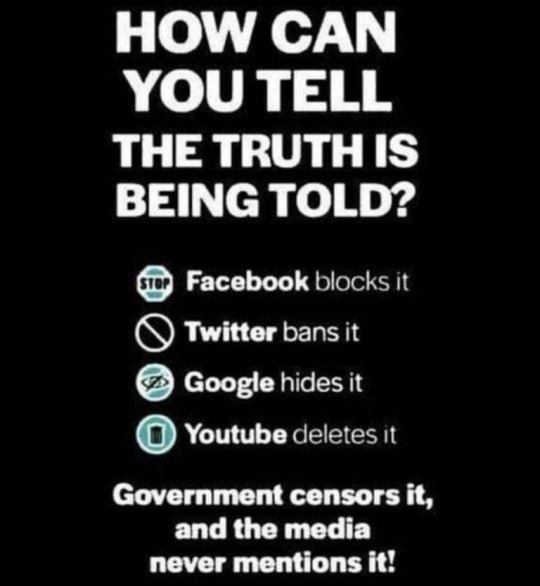
In the 24 hours since Project Veritas posted this footage, it has been viewed more than 12 million times on Twitter. So, the public is very interested. Why wouldn't they be? But the media are not. No other media outlet has covered the story at all. We checked. MSNBC and CNN, which perhaps not coincidentally, take huge amounts of advertising dollars from Pfizer, those two channels have devoted a total of zero seconds to the story. Well, just go online and find out about it. Well, Google, the biggest search engine in the world, which has a monopoly on search in this country, appears to have gone out of its way to make it much more difficult for users to learn anything about the Pfizer executive pictured in the footage and so there is, in other words, on television and in most places online, a near-total media blackout of this story.
#Gratitude Tucker Carlson#Project Veritas#Media#Censorship#PlanDemic#Pfizer#Gain Of Function#Follow the Money#Pfizer director assaults James O’Keefe Project Veritas journalists after being confronted over comments on ‘mutating’ COVID-19 virus
13 notes
·
View notes
Text
By Lambert Strether of Corrente.
On May 25 of this year, JAMA published Development of a Definition of Postacute Sequelae of SARS-CoV-2 Infection (“Definition”), an “original investigation” whose authors were drawn from the RECOVER Consortium, an initiative of the National Institutes of Health (NIH)[1]. This was an initially welcome development for Long Covid sufferers and activists, since questions had arisen about what exactly patients were getting for the billion dollars RECOVER was appropriated. From STAT:
The federal government has burned through more than $1 billion to study long Covid, an effort to help the millions of Americans who experience brain fog, fatigue, and other symptoms after recovering from a coronavirus infection.
There’s basically nothing to show for it.
The National Institutes of Health hasn’t signed up a single patient to test any potential treatments — despite a clear mandate from Congress to study them.
Instead, the NIH spent the majority of its money on broader, observational research that won’t directly bring relief to patients. But it still hasn’t published any findings from the patients who joined that study, almost two years after it started.
(The STAT article, NC hot take here on April 20, is worth reading in full.) Perhaps unfairly to NIH — one is tempted to say that the mountain has labored, and brought forth a coprolite — a CERN-level headcount may explain both RECOVER’s glacial pace, and its high cost:
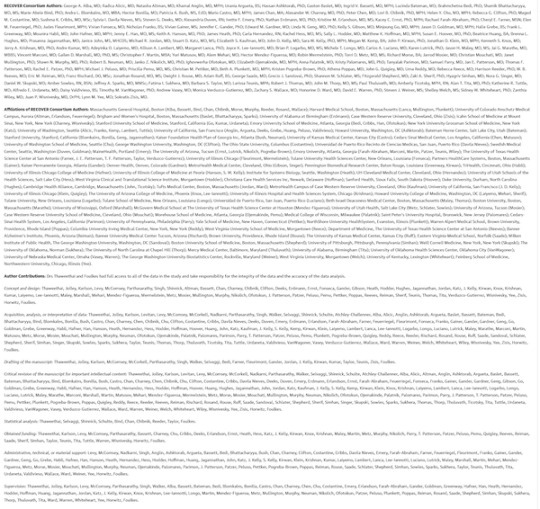
That’s a lot of violin lessons for a lot of little Madisons!
“Definition” falls resoundingly into the research (and not treatment) bucket. In this post, I will first look at the public relations debacle (if debacle it was) that immediately followed its release; then I will look at its problematic methodology, and briefly conclude. (Please note that I feel qualified to speak on public relations and institutional issues; very much less so on research methodology, which actually involves (dread word) statistics. So I hope readers will bear with me and correct where necessary.)
The Public Relations Debacle
Our famously free press instantly framed “Definition” as a checklist of Long Covid (LC) symptoms. Here are the headlines. For the common reader:
12 key symptoms define long Covid, new study shows, bringing treatments closer CNN
Long COVID is defined by these 12 symptoms, new study finds CBS
Scientists Identify 12 Major Symptoms of Long Covid Smithsonian
These 12 symptoms may define long COVID, new study finds PBS News Hour
These Are the 12 Major Symptoms of Long COVID Daily Beast
(We will get to the actual so-called “12[2] Symptoms” when we look at methodology.) And for readers in the health industry:
For the first time, researchers identify 12 symptoms of long covid Chief Healthcare Executive
12 symptoms of long COVID, FDA Paxlovid approval & mpox vaccines with Andrea Garcia, JD, MPH AMA Update
Finally! These 12 symptoms define long COVID, say researchers ALM Benefits Pro
With these last three, we can easily see the CEO handing a copy of their “12 symptoms” article to a doctor, the doctor double-checking that headline against the AMA Update’s headline, and incorporating the NIH-branded 12-point checklist into their case notes going forward, and the medical coders at the insurance company (I love that word, “benefits”) nodding approvingly. At last, the clinicians have a checklist! They know what to do!
We’ll see why the whole notion of a checklist with twelve items is wrong and off-point for what “Definition” was actually, or at least putatively, trying to do, but for now it’s easy to see why the press went down this path (or over this cliff). Here is the press release from NIH that accompanied “Definition”‘s publication in JAMA:
Researchers examined data from 9,764 adults, including 8,646 who had COVID-19 and 1,118 who did not have COVID-19. They assessed more than 30 symptoms across multiple body areas and organs and applied statistical analyses that identified 12 symptoms that most set apart those with and without long COVID: post-exertional malaise, fatigue, brain fog, dizziness, gastrointestinal symptoms, heart palpitations, issues with sexual desire or capacity, loss of smell or taste, thirst, chronic cough, chest pain, and abnormal movements.
They then established a scoring system based on patient-reported symptoms. By assigning points to each of the 12 symptoms, the team gave each patient a score based on symptom combinations. With these scores in hand, researchers identified a meaningful threshold for identifying participants with long COVID. They also found that certain symptoms occurred together and defined four subgroups or “clusters” with a range of impacts on health
So there are 12 symptoms, right? Just like the headline says? Certainly, that’s what a normal reader would take away. And if a temporally pressed reporter goes to the JAMA original and searches on “12”, they find this:
Using the full cohort, LASSO identified 12 symptoms with corresponding scores ranging from 1 to 8 (Table 2). The optimal PASC score threshold used was 12 or greater
And if the reporter goes further and finds Table 2 (we’ll get there when we look at methodology), they will see, yes, 12 symptoms (in rank order identified by something called LASSO).
So it’s easy to see how the headlines were written as they were written, and how the newsroom wrote the stories as they did. The wee problem: The twelve symptoms are not meant to be used clinically, for diagnosis.[3], Lisa McCorkell was the patient representative[4] for the paper, and has this to say:

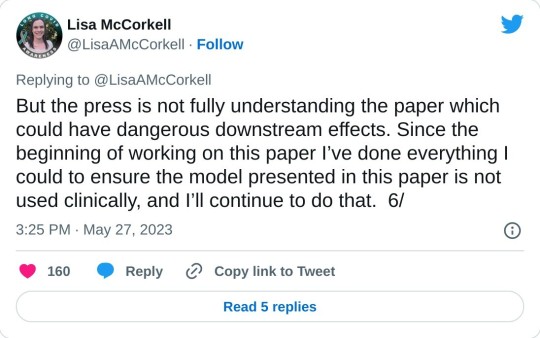
Nevertheless, the “12 symptoms” are out of the barn and in the next county, and as a result, you get search results like this:
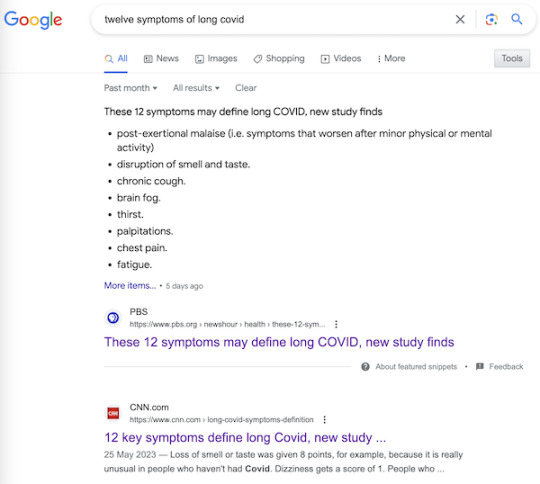
It’s very easy to imagine a harried ER room nurse hearing “12 Symptoms” on the TV news[5], doublechecking with a Google search, and then making clinical decisions based on a checklist not fit for purpose. Or, for that matter, a doctor.
Now, to be fair to the authors, once one grasps the idea that symptoms, even clusters of symptoms, can exist, and still not be suitable for diagnosis by a clinician, the careful language of “Definition” is clear, starting with the title: “Development of a Definition.” And in the Meaning section of the Abstract:
A framework for identifying PASC cases based on symptoms is a first step to defining PASC as a new condition. These findings require iterative refinement that further incorporates clinical features to arrive at actionable definitions of PASC.
Well and good, but do you see “framework” in the headlines? “Iterative”? “First step”? No? Now, I’d like to exonerate the authors of “Definitions” — “They’re just scientists!” — for that debacle, but I cannot, completely. The authors are well-compensated, sophisticated, and aware professionals; PMC, in fact. I cannot believe that the Cochrane “fools gold” antimask study debacle went unobserved at NIH, especially in the press office. How was it possible that “Definitions” was simply… printed as it was, and no strategic consideration given to shaping the likely coverage?[6] One obvious precautionary measure would have been a preprint, but for reasons unknown to me, NIH did not do that. A second obvious precautionary measure would have been to have the patient representative approve the press release. Ditto. Now let us turn to methodology.
The Problematic Methodology
First, I will look at issues with Table 2, which presents the key twelve-point checklist, and names the algorithm (although without explaining it). After that, I will branch out to a few larger issues. Again I issue a caveat that I’m not a Long Covid maven or a statistics maven, and I hope readers will correct and clarify where needed.
Here is Table 2:
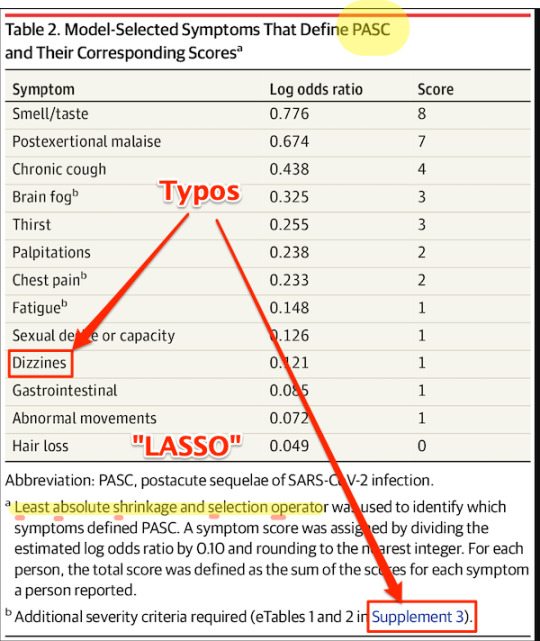
First, some copy editing trifles (highlighted). On “PASC”: As WebMD says: “You might know this as ‘long COVID.’ Experts have coined a new term for it: post-acute sequelae SARS-CoV-2 infection (PASC).” Those lovable scamps, always inventing impenetrable jargon! (Bourdieu would chuckle at this.) On “Dizzines”: Come on. A serious journal doesn’t let a typo like that slip through (maybe they’re accustomed to fixing the preprints?). On “Supplement 3”: The text is highlighted as a link, but clicking it brings up the image, and doesn’t take you to the Supplement. These small errors are important[7], because they indicate that no editor took more than a cursory look at the most important table in the paper. On “LASSO,” hold that thought.
Second, the Covid Action Network points out that some obvious, and serious, symptoms are missing from the list:
[T]he next attempts at diagnostic criteria should take into account existing literature that shows more specifically defined symptoms for Long Covid, from objective findings. (E.g. PoTS, Vestibular issues, migraine, vs more vague symptoms like “headache” or “dizziness.) [The Long Covid Action Project (LCAP)] noticed that while [Post-Extertional Malaise (PEM)] was used as a specific symptom with a high score to produce PASC-positive results, other suites of symptoms, like those in the neurologic category, could have produced an equal or higher score than PEM if questionnaires had not separated neuro-symptoms into multiple subtypes and reduced their total scores. This alone could have created a more scientifically accurate picture of the Long Covid population.
Third, these symptoms — missing, from the patient perspective; to be iterated from the researcher’s perspective, at least one would hope — are the result of “Definition”‘s methodology:

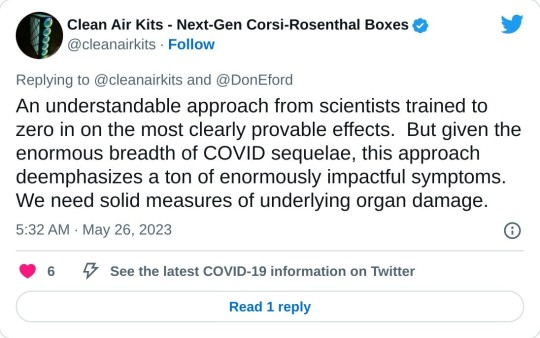
Fourth, I would argue focus on the “most clearly provable effects” — as opposed to organ damage — is a result of the “LASSO” algorithm named in Table 2. I did a good deal of searching on LASSO, and discovered that most of the examples I could find, even the “real world” ones, were examples of how to run LASSO programs, as opposed to selecting the LASSO algorithm as opposed to others. So that was discouraging. I believe — reinforcing the caveats, plural, given above — that I literally searched on “LASSO” “child of five” (“Explain it to me like I’m five”) to finally come up with this:
Lasso Regression is an essential variable selection technique for eliminating unnecessary variables from your model.
This method can be highly advantageous when some variables do not contribute any variance (predictability) to the model. Lasso Regression will automatically set their coefficients to zero in situations like this, excluding them from the analysis. For example, let’s say you have a skiing dataset and are building a model to see how fast someone goes down the mountain. This dataset has a variable referencing the user’s ability to make basketball shots. This obviously does not contribute any variance to the model – Lasso Regression will quickly identify this and eliminate these variables.
Since variables are being eliminated with Lasso Regression, the model becomes more interpretable and less complex.
Even more important than the model’s complexity is the shrinking of the subspace of your dataset. Since we eliminate these variables, our dataset shrinks in size (dimensionality). This is insanely advantageous for most machine learning models and has been shown to increase model accuracy in things like linear regression and least squares.
Since LC is said to have over 200 candidates for symptoms, you can see why a scientist trying to get their arms around the problem would be very happy to shrink those candidates to 12. But is that true to the disease?
Because LASSO (caveats, caveats) has one problem. From the same source:
One crucial aspect to consider is that Lasso Regression does not handle multicollinearity well. Multicollinearity occurs when two or more highly correlated predictor variables make it difficult to determine their individual contributions to the model.
Amplifying:
Lasso can be sensitive to multicollinearity, which is when two or more predictors are highly correlated. In this case, Lasso may select one of the correlated predictors and exclude the other [“set their coefficients to zero”], even if both are important for predicting the target variable.
As Ted Nelson wrote, “Everything is deeply intertwingled” (i.e., multicollinear), and if there’s one thing we know about LC, it’s that it’s a disease of the whole body taken as a system, and not of a single organ:
There are some who seek to downplay Long Covid by saying the list of 200 possible symptoms makes it impossible to accurately diagnose and that it could be encompassing illnesses people might have gone on to develop anyway, but there are sound biological reasons for this condition to affect the body in so many different ways.
Angiotensin-converting enzyme receptor 2 (ACE2) is the socket SARS-CoV-2 plugs into to infect human cells. The virus can use other mechanisms to enter cells=, but ACE2 is the most common method. ACE2 is widely expressed in the human body, with highest levels of expression in small intestine, testis, kidneys, heart, thyroid, and adipose (fat) tissue, but it is found almost everywhere, including the blood, spleen, bone marrow, brain, blood vessels, muscle, lungs, colon, liver, bladder, and adrenal gland
Given how common the ACE2 receptor is, it is unsurprising SARS-CoV-2 can cause a very wide range of symptoms.
In other words, multicollinearity everywhere. Not basketball players vs. skiiers at all.
So is LASSO even the right algorithm to handle entwinglement, like ACE2 receptors in every organ? Are there statistics mavens in the readership who can clarify? With that, I will leave the shaky ground of statistics and Table II, and raise two other issues.
First, it’s clear that the population selected for “Definitions” is unrepresentative of the LC population as a whole:
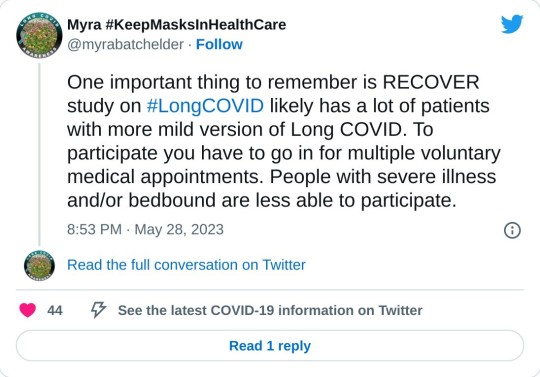
If the patients in “Definition” are not so ill, that might also account for Table 2’s missing symptoms.
Second, “Definition”‘s questionnaires should include measures of severity, and don’t:

Conclusion
The Long Covid Action Project (materials here) is running a letter writing campaign: “Request for NIH to Retract RECOVER Study Regarding 12 Symptom PASC Score For Long Covid.” As of this writing, “only 3,082 more until our goal of 25,600.” You might consider dropping them a line.
Back to the checklist for one moment. One way to look at the checklist is — we’re talking [drumroll] the PMC here — as a set of complex eligibility requirements, whose function is, as usual, gatekeeping and denial:
what they did is create basically a means test to figure out a dx but for smthg that is still not fully understood. it's premature and rly limited, & this will only further aid ppl already dismissive of lc
— Wendi Muse (@MuseWendi) June 3, 2023
If you score 12, HappyVille! If you score 11, Pain City! And no consideration given to the actual organ damage in your body. And after the last three years following CDC, I find it really, really difficult to give NIH the benefit of the doubt. If one believed that NIH was acting in bad faith, one would see “Definition” as a way to keep the funding gravy train rolling, and the “12 Symptoms” headlines as having the immediate and happy outcome of denying care to the unfit. Stay safe out there, and let’s save some lives!
NOTES
[1] Oddly, the JAMA paper is not yet listed on RECOVER’s publications page.
[2] “12” is such a clickbait-worthy brainworm. “12 Days of Christmas,” “12 apostles,” “12 steps,” “12 months,” “12 signs of the zodiac,” etc. One might wonder where if the number had been “9” or “14” the uptake would have been so instant.
[3] To be fair to the sources, most of them mention this: Not CBS, Chief Health Care Executive, or the Daily Beast, but CNN in paragraph 51, Smithsonian (9), PBS (20), AMA Update (10), and Benefits Pro (17).
[4] There was only one patient representative for the paper:

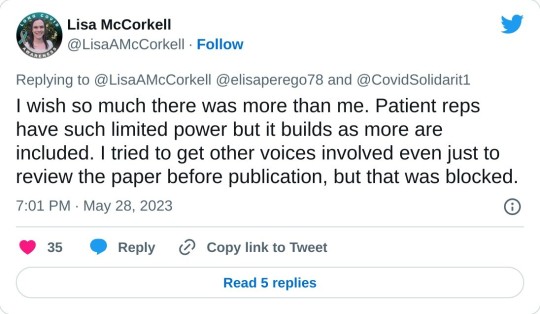
One seems low, especially given the headcount for the project.
[5] I was not able to find a nursing journal that covered the story.
[6] Unless it was, of course.
[7] Samuel Johnson: “When I take up the end of a web, and find it packthread, I do not expect, by looking further, to find embroidery.”
#long covid#naked capitalism#lambert strether#national institutes of health#covid pandemic#covid 19#long covid action project#long covid awareness day
5 notes
·
View notes
Video
#WDC#DC#2020#Washington DC#Corona Virus (COVID-19) Project#Coronavirus COVID-19 Washington DC#Street Photography#Street Photography 2020#Washington DC Street Photography#Washington DC Street Photography 2020#November 2020#COVID-19 Project Part 3 Fall 2020#Election 2020#After The Election Project#After The Election 2020 Project#Protest Photography 2020#14 November 2020#Saturday#14 November 2020 Washington DC#14 November 2020 Trip to / from Washington DC for Million MAGA March#14 November 2020 Million MAGA March in support of President Donald Trump / Washington DC#Protest Photography#14 November 2020 Million MAGA March Rally#14 November 2020 Million MAGA March Rally @ Freedom Plaza at 13th & E Street#NW#MPDC 2020#Cops#Cops 2020#Police#Police 2020
6 notes
·
View notes
Text



#good law project#political twitter#dawn butler brent#ppe scandal#uk covid 19 response#conservative party#boris johnson#uk economy#uk politics#uk news#pandemic
33 notes
·
View notes
Photo

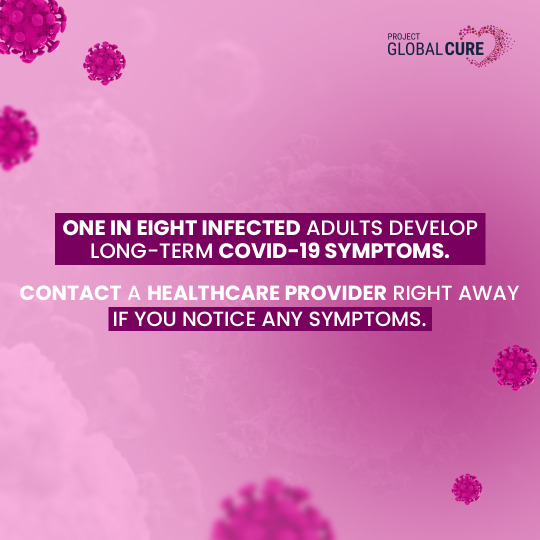




An appeal to people to follow Covid appropriate protocols - up to 50% of infected individuals do not show symptoms. Covid is not over yet. https://www.projectglobalcure.org/medical-awareness/coronavirus-%28covid-19%29
2 notes
·
View notes
Text
working from home save me
working from home
save me working from home
#pls pray that my next project will remain online i don’t want to go to the office#aesukhia posts#work from home#digital nomad#covid 19#spoonie#long covid
0 notes
Text
#projectbluebeam
Enough said and coming to a sky near you as early as 2024.
It's trending on Twitter. Go check out how easy it is to deceive the people.

#megxit#youtube#canada#freedom convoy#ottawa convoy#freedom#ottawa#covid 19 otttawa#convoy#justin trudeau#one world government#project blue beam#aliens and ufos
2 notes
·
View notes

